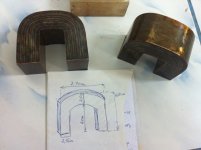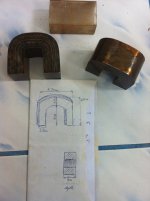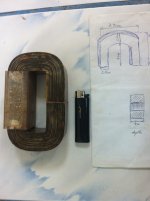Hello guys,
Please help me with the formula calculations for a c-core and double c-core transformer.
I have searched the forum and couldn't find any calculations for it, so if anybody has calculation formulas, please poste them here because i think there would be allot of coleagues from this forum that would be interested.
I have the c-core sheets in the photo and i'm wondering what power cand i get from it.
Cand i get +-25volts at 12 amps in the secondary winding from it (600W)?
The Ual is 220V/50Hz.
What has more advantages, in therms of riple and efficiency, a c-core like this or a double c-core like the one used by Jean Hiraga (in "Le classe A amp") or Audionote in their valve amps?
I want to make a class A amp and was wondering about if i should buy another c-core transformer to couple it with this one or wind only this transformer.
Thans.
Ps: this transformer has been taken from a rusty old philips tv and painted with lacquer.
Please help me with the formula calculations for a c-core and double c-core transformer.
I have searched the forum and couldn't find any calculations for it, so if anybody has calculation formulas, please poste them here because i think there would be allot of coleagues from this forum that would be interested.
I have the c-core sheets in the photo and i'm wondering what power cand i get from it.
Cand i get +-25volts at 12 amps in the secondary winding from it (600W)?
The Ual is 220V/50Hz.
What has more advantages, in therms of riple and efficiency, a c-core like this or a double c-core like the one used by Jean Hiraga (in "Le classe A amp") or Audionote in their valve amps?
I want to make a class A amp and was wondering about if i should buy another c-core transformer to couple it with this one or wind only this transformer.
Thans.
Ps: this transformer has been taken from a rusty old philips tv and painted with lacquer.
Attachments
The transformer's formula's do not depend on the core shape, you can use the usual ones, ie 4.4*B*F*Ae for the volt/turn and compute the power from the copper window, the current density you allow and your winding skills.
You will certainly not get 600W from this core in 50Hz: even assuming high quality iron, you will get something like 200~250mV/turn
You will certainly not get 600W from this core in 50Hz: even assuming high quality iron, you will get something like 200~250mV/turn
question
But how about 300w? (25-0-25V on 6A)
I didn't know that i can use the same formulas. What intriguates me is the calculations for the total surface area. Can you give me that formula, please?
What is the formula for the total surface of the core for the c-core?
Thank you very much.
Ps: i want to make this trafo to compare the JLH@30W (dual rail supply), the "Le classe A amp" and "The little cheap Circlophone", and then make a final decision and build it in stereo (of course, with two of these trafos).
The transformer's formula's do not depend on the core shape, you can use the usual ones, ie 4.4*B*F*Ae for the volt/turn and compute the power from the copper window, the current density you allow and your winding skills.
You will certainly not get 600W from this core in 50Hz: even assuming high quality iron, you will get something like 200~250mV/turn
But how about 300w? (25-0-25V on 6A)
I didn't know that i can use the same formulas. What intriguates me is the calculations for the total surface area. Can you give me that formula, please?
What is the formula for the total surface of the core for the c-core?
Thank you very much.
Ps: i want to make this trafo to compare the JLH@30W (dual rail supply), the "Le classe A amp" and "The little cheap Circlophone", and then make a final decision and build it in stereo (of course, with two of these trafos).
total area of the c-core
At last, i have found the total area surface formula in a book from a internet database:
End=height*lenght (square cm)
Top= lenght*width (square cm)
Side= hight*widht (square cm)
Surface area: 2*End+2*Top+2*Side (square cm)
Long lives g***le books. 😎😀
At last, i have found the total area surface formula in a book from a internet database:
End=height*lenght (square cm)
Top= lenght*width (square cm)
Side= hight*widht (square cm)
Surface area: 2*End+2*Top+2*Side (square cm)
Long lives g***le books. 😎😀
The effective iron area has to be computed from the cross-section of one leg, in your case 2.5*4=10cm², but that is the raw section, you have to apply a filling ratio, 0.9 or 0.95 for example.
is this the correct formula?
1. Elvee is this the correct formula for double c-core from the link below?
Transformer and Inductor Design Handbook - Colonel Wm. T. McLyman, Colonel William T. McLyman - Google C?r?i
😕😕😕
The effective iron area has to be computed from the cross-section of one leg, in your case 2.5*4=10cm², but that is the raw section, you have to apply a filling ratio, 0.9 or 0.95 for example.
1. Elvee is this the correct formula for double c-core from the link below?
Transformer and Inductor Design Handbook - Colonel Wm. T. McLyman, Colonel William T. McLyman - Google C?r?i
😕😕😕
2.5cm by 4cm ~1.55sq"
that allows ~31*1.55² = 74VA if 1T is the core flux.
If the steel will allow you could run at 1.8T giving a maximum of 134VA
If it's cheap steel, then it could well be <70VA.
that allows ~31*1.55² = 74VA if 1T is the core flux.
If the steel will allow you could run at 1.8T giving a maximum of 134VA
If it's cheap steel, then it could well be <70VA.
- Status
- Not open for further replies.
- Home
- Amplifiers
- Power Supplies
- Calculation formulas for c-core/double c-core transformer


